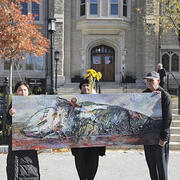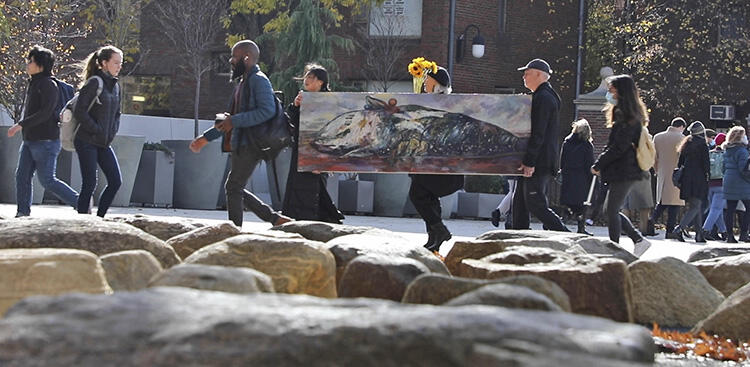
On a recent November morning, the hustle of Harvard Yard was interrupted by the steady glide of a North Atlantic right whale.
From Massachusetts Avenue to Cambridge Common and across the Science Center Plaza to the Divinity School, the more than 6-foot long painting—masterfully created by MTS candidate Maisie Luo—was carried in a sort of funeral procession to raise awareness of the plight of the North Atlantic right whale and honor the animal. With an estimated population of no more than 350, it is one of the world’s most endangered large whale species, according to the National Oceanic and Atmospheric Administration Fisheries office.
The painting, titled “With a North Atlantic Right Whale,” depicts a beached right whale on its side tangled in fishing net and with cuts around its waist from boats and cruise ships. In the middle is a human, attempting to detangle the net. It is one of nearly a dozen works Luo is currently creating for her master’s thesis exploring the interconnectedness between humans and nonhuman beings in the climate crisis.
“The process of bearing witness to art and facing the reality can sometimes wake people up and make them aware of the consequences,” said Luo. “One can know all these facts about climate change, all these facts about whales suffering, but still not act on it because we’re so distant.”
Luo credits her advisors, Terry Tempest Williams, Harvard Divinity School writer-in-residence and environmentalist, and Janet Gyatso, Hershey Professor of Buddhist Studies and HDS Associate Dean for Faculty and Academic Affairs, with encouraging her to think about, in addition to writing, the power of images and of ways to raise awareness and communicate with the world.
Luo is purposeful in the material she includes in her paintings. She uses materials from the trash she produces daily and other items she finds to reflect on the consequences of our actions and choices on the environment. The fishing net on the whale is from a bag of tangerines Luo bought. Broken phone cords make up the ropes around the whale. Used coffee grounds and wilted grass are other items she incorporates in her creations.
But she also uses items like seashells she collected from a beach in Massachusetts, next to the waters of the North Atlantic right whale, as a gesture of healing and paying respect to the animal by offering something from its home.
When she was a teenager, Luo watched the documentary Albatross, which highlighted the mass death of the bird near Midway Island from consuming plastic waste dumped in the Pacific Ocean. The film came back into Luo’s life when it was included in a course she took with Williams, who also joined the art walk as the flower bearer.
“I’ve been thinking about the albatross since that documentary,” Luo said. “I feel very entangled with them. What was really significant about the documentary is that Midway Island is between the United States and China, both places I call home, and both places contribute to putting more plastics in the ocean.”

Luo, who has studied and practiced art since moving to the United States at 13, imagined the feeling of having a stomach full of plastic. That haunting feeling turned into the piece “With a Young Albatross,” which inspired the series.
The striking image depicts a grassy shoreline with an albatross and a smaller human figure kneeling and bent over at the stomach, both with their mouths open as if choking.
“My drive as a painter in the ongoing climate crisis is to create images that let more people bear witness to the suffering and joy in the entangled world and act more compassionately towards all beings,” Luo said. “I think about the limitation of language and concepts in conveying the felt sense of being entangled with other beings on earth, and I wonder what images can do to create opportunities to let more people ‘encounter’ these animals and plants and connect with them in a way that makes them feel the need to take actions.”
Gyatso, one of Luo’s advisors, said Luo’s work explores the interdisciplinary aspect of religion.
“Her paintings deeply engage really important ethical issues around our human place in the cosmos, our obligation to the world in which we live and especially the creatures within the world that we live,” said Gyatso. “Religion teaches us about our moral responsibilities, and in my opinion, the most important thing we’re doing at Harvard Divinity School is teaching ethics. Religion is very much about giving human beings ethical guidance and ethical principles by which to live. This is what we do at HDS. We train people to take what they learn here and apply it not only in various branches of academia, but also in practical, real life situations.”
At HDS, Luo focuses her studies on ethics and said the training she’s received and classes she has taken have allowed her to think about “how we ought to be in this world and how religion, spirituality, rituals, and practices can help form a more ethical, loving, and compassionate world.”
“I really see that as the bigger goal for me as a person living in this moment of all kinds of crisis,” she said. “If religion and spirituality have that goal of making a more compassionate world, my work maybe offers pathways to take us closer to that. At least that’s my motivation.”
—Written by Michael Naughton. Caroline Cataldo contributed to this report.